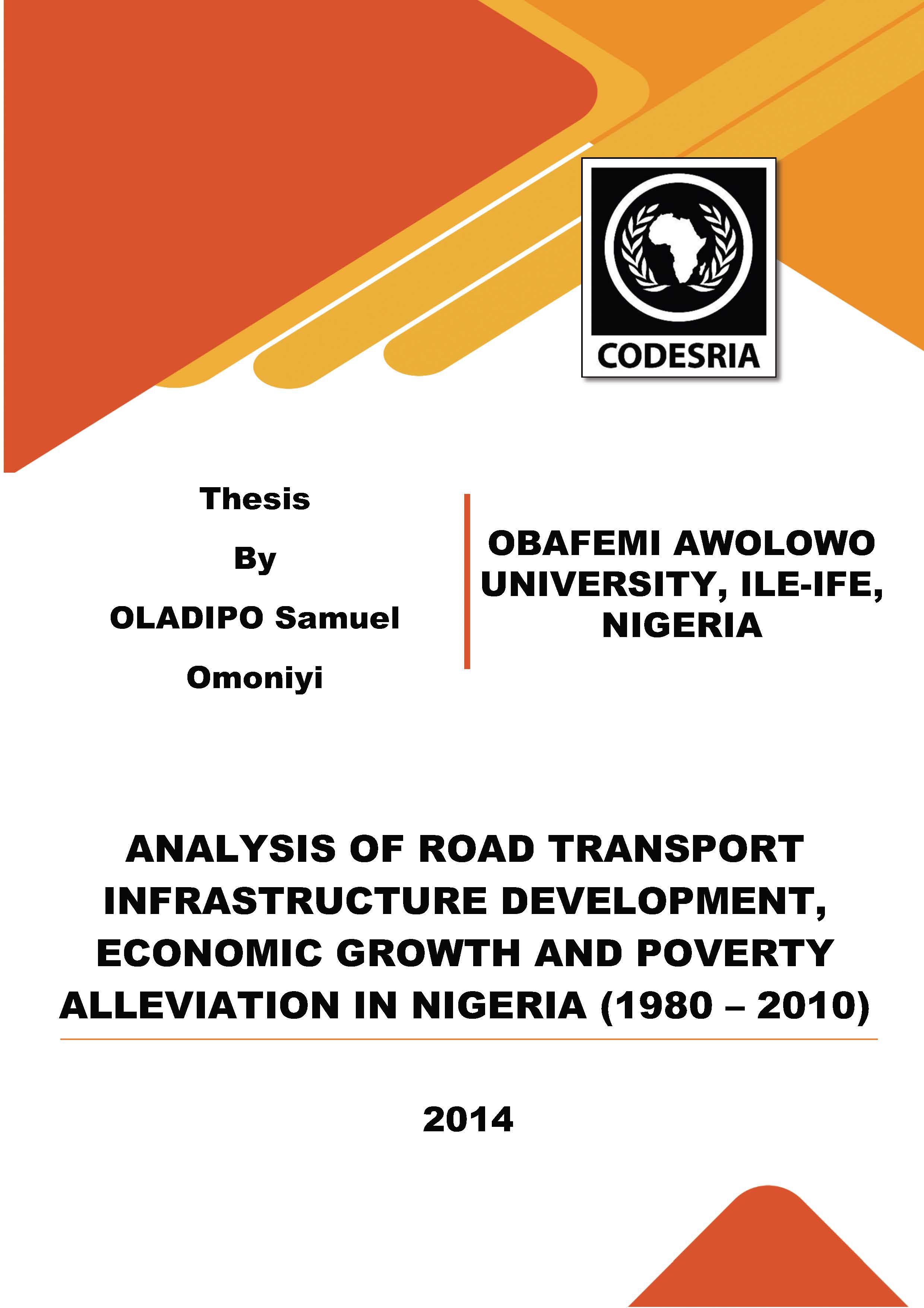ANALYSIS OF ROAD TRANSPORT INFRASTRUCTURE DEVELOPMENT, ECONOMIC GROWTH AND POVERTY ALLEVIATION IN NIGERIA (1980 – 2010)
Keywords:
ROAD TRANSPORT, INFRASTRUCTURE, DEVELOPMENT, POVERTY, NIGERIASynopsis
This study examined the relationship existing among road transport infrastructure development, economic growth and poverty level in the Nigerian economy. It specifically analysed the long run relationship among road transport infrastructure development, economic growth and poverty level, determined the causal effects and the direction of causality, both in the long run and the short-run. The interactive effects among road transport infrastructure, economic growth and poverty level in Nigeria were also examined. This was with the view to providing empirical evidence on the possible linkages among road transport infrastructure, economic growth and poverty level.
The study employed annual time series data from 1980 to 2010 collected from Central Bank of Nigeria (CBN) Statistical Bulletin (2010), National Bureau of Statistics (NBS) various publications and World Development Indicators (2010) published by the World Bank. Both descriptive statistics and econometric techniques were employed in the study. The Structural Vector Autoregressive (SVAR) econometric technique was applied in the analysis of standard neoclassical macroeconomic framework. In addition, Cointegration, Impulse Response Function (IRFs), Forecast Error Variance Decomposition (FEVD) and Granger Causality Test (GCT) were used as analytical tools.
The result showed that road transport infrastructure development growth rate was very low relatively to economic growth rate over the years. The result further showed that economic growth was increasing over the year. However, poverty was on the high side given the trend analysis. The cointegration test confirmed the existence of long run relationship among road transport infrastructure development, economic growth and poverty reduction. It also indicated that 1 per cent increase in road transport infrastructure development and economic growth reduced poverty level by about 1percent (t-value= 1.64, P>0.05) and 0.6 per cent (t-value=4.27, P<0.05) respectively. The SVAR results indicated that an unanticipated 1 percent increase in road transport infrastructure development led to an increase of only 0.06 per cent, 0.19 per cent and 0.24 per cent in economic growth at the 1st, 5th and 10th periods and reduces thereafter. Also, is the positive response of about 0.14 per cent and 0.27 per cent produced by real consumption expenditure per capita, as a proxy for poverty reduction in the 1st and 5th period before it fell gradually to about 0.10 per cent in the 35th period due to an innovation in road transport infrastructure development. Further, real consumption expenditure per capita increased immediately by 0.04 per cent following an innovation
in economic growth at the 1st period but falls also thereafter. The FEVD revealed that at the 20th period road transport infrastructure development contributed about 70 per cent to the forecast error variance of economic growth and about 49.5 per cent to the forecast error variance of the real consumption expenditure per capita, while economic growth contributed about 17 per cent and 4.5 per cent to the fluctuation in poverty reduction and road transport infrastructure development respectively at the 20th period. Poverty reduction shock also accounted for only 3 per cent and 6 per cent of the forecast error
variance of road transport infrastructure development and economic growth respectively at the 20th period. The Granger causality result indicated that road transport infrastructure development and economic growth were the sources of poverty reduction in the long run and that poverty reduction and economic growth could influence one another in the short run.
The study concluded that road transport infrastructure development had impacted positively on economic growth and poverty reduction in the Nigeria.
Downloads
References
Conrad, K. and Seitz H. (1994). The Economic Benefits of Public Infrastructure, Journal of Applied Economics 26, 303- 311.
Costa, J.S., Ellson, R.W., Martin, R.C. (1987). ―Public capital, regional output, and development: some empirical evidence.‖ Journal of Regional Science, 27(3), 419-437.
Coughlin, C.C. and Segev, E., (2000). "Location Determinants of New Foreign-Owned Manufacturing Plants", Journal of Regional Science, Blackwell Publishing, vol. 40(2), pages 323-351.
Crane, L.M., Burke, D. and Hanks, C. (1991). Highway District and Economic Sector Employment Effects of Transportation Expenditures, Transportation Research Record 1305, 190-200.
Crihfield, J.B. and Panggabean, M.P.H. (1996). The Structure of Metropolitan Factor and Product Markets, Journal of Regional Science 36, 17-41.
Dalenberg, D.R. and Partridge, M.D. (1995). The Effects of Taxes, Expenditures, and Public Infrastructure on Metropolitan Area Employment, Journal of Regional Science 35, 617-640.
Dalenberg, D. R., Partridge M. D. and Rickman d.S. (1998) Public infrastructure: Pork or jobs creator? Public Finance Review 26, 24-52.
Darat, A. E. (1996). Trade and development: The Asian Experience. Cato Journal, 6: 695-699
Datt, G., and Ravalion, R. (2011). Has India‘s Economic Growth Become Poorer in the Wake of Economic Reforms. World Bank Economic Review, 25(2), 157-189.






